
Recovering from a sports injury
Peer reviewed by Dr Sarah Jarvis MBE, FRCGPLast updated by Danny ChadburnLast updated 20 Sept 2017
Meets Patient’s editorial guidelines
- DownloadDownload
- Share
- Language
- Discussion
A serious sports injury can have a huge impact on your life, especially if it affects your mobility. However frustrating the situation might be, it's still important to take your time and gradually rebuild your strength to avoid risk of further injury.
In this article:
If you do get injured and you're out of action for a period of time, there are many things that can be done to help speed up recovery. In the early stages of an injury it is massively important to look after it.
So for ankle and knee ligament injuries, a lot of ice is needed to help reduce swelling and compression is also often tried to aid this treatment. It's also helpful to keep the leg up (ideally above the level of your hip) and to try to keep off your feet as much as possible. Your physiotherapist (if you have one), will usually tell you what you need to do and when. Short-term recovery is all about PRICE - Protecting your joint, Rest, Ice, Compression and Elevation.
Rest and relaxation are extremely important but it is understandable that some people will want to get back on their feet as soon as possible. This needs to be a gradual process that requires a lot of patience. Here are some of the best ways of getting yourself back on your feet.
Stay focused
While you might not be able to pick back up the same exercise routine you had before your injury, it doesn't mean you have to stop altogether. Check with your doctor or physiotherapist what exercises are safe before starting your new routine. Take it slowly at first and don't push yourself too hard - remember you're still in recovery.
Beat the boredom
Recovery periods can be frustrating and boring, especially if your injury is restricting your movement. Don't let it get the better of you. Keep yourself occupied with other activities and pick up a new hobby. You never know, you might discover a whole new talent.
Factor in rest
While it can be tempting to carry on with your usual routine, don't forget your body needs rest. This is even more important during the recovery period, as you'll heal much faster if you listen to what your body's needs.
Keep moving
While rest is important, keeping yourself mobile is also an integral part of recovery. Keeping up with the exercises prescribed by your physiotherapist is vital - once you've established a routine, you should find it easier.
Follow a healthy diet
As tempting as it may be, don't let an injury become an excuse for poor diet. If your mobility has been affected, it can be easy to fall into bad eating habits and gain unwanted weight. Keep yourself occupied, list what you're eating and draw up a meal plan. Your body will thank you for it.
Continue reading below
Preventing the injury from recurring
Typically, the areas on your body that become prone to injury more than others are your back, shoulders and knees.
The back is primarily at risk because it's often used (incorrectly) to lift items from the ground while your shoulders and knees are used frequently because of their high ranges of motion.
The most common reason a person exercises is to build muscle in order to become leaner and stronger, but we often forget that the primary area we should focus on is health and prevention. A proper exercise routine is capable of preventing injuries that may pop up along the way because of various reasons such as age or everyday activities. Warming up and stretching help a lot but these top exercises may help you to avoid future injury.
Preventive back exercises
The following back exercises may be of help:
Back raises - this exercise is often performed to strengthen what is known as your erector spinae muscle group, which are muscles and tendons that run alongside of your spine. They support your torso with your abdominal muscles, so both should get equal attention. The stronger your erector spinae, the less likely you are to injure your back.
Straight-leg deadlifts - also known as 'stiffed-leg deadlifts'. The exercise is performed while your knees are slightly bent, and you bend at the hips while your legs are straight to lift the barbell or dumbbells from the ground. Targeted muscle groups are your back and hamstrings but you still get a full body workout because it is a compound lift - meaning it exercises multiple muscle groups.
Preventive shoulder exercises
The following shoulder exercises may be of help:
Shoulder press - the other name you might have heard for this is the military press. The exercise is performed by pressing dumbbells or a barbell over your head, but resistance cables can be used as well. The intent is to help your shoulders strengthen through range of motion. Never lock out your elbows or extend your arms too high because serious injury can occur.
Front and lateral raises - both exercises together target your entire shoulder muscle. They allow your shoulders to strengthen while also creating enough range of motion to basically teach your body to be accustomed to that type of movement. Lateral means you are lifting the weight directly from your sides until parallel with the floor, while front raises start from the front of your body and are lifted to chest level.
Preventive knee exercises
The following knee exercises may be of help:
Squats - another compound lift that is known to be the Holy Grail for leg training. Performing this exercise will strengthen your knees while also keeping the muscles around the joint strong as well. Remember, keep your back straight, chest out, and bend at the hips to lower the weight down. Then, as you lift the weight back up, you drive your hips forward and stop before your knees are locked. Locking your knees can cause serious injury over time.
Leg extensions - your quadriceps (the large upper leg muscles on the front side) are responsible for a lot of the motions your knees go through. Hence the reason for them needing to be strong and placed under their own range of motion. This exercise is great for those who have not experienced severe knee pains, but if you have faced this pain, keep the weights light in order to get used to this muscle-strengthening exercise.
Keeping injuries at bay
The stronger your back, knees and shoulders are, the less likely it is that injuries will come knocking at your door.
Whether you take on some of the exercises above or others that take your fancy, keep in mind that lower weight settings are advised if you are new to fitness training or if you're in recovery. And always seek medical consultation if you have had any serious injuries in the past.
Patient picks for Sports injuries

Bones, joints and muscles
When is it safe to return to sport after an injury?
If you’ve been injured playing football – or through any other sport – you’re probably impatient for the injury to heal so you can get back to normal. While the situation is most acute for professional sportspeople, who may miss important matches or even whole seasons, it can still be tough for ordinary people who have made sport a big part of their life.
by Abi Millar

Bones, joints and muscles
Beyond the burn: decoding the HYROX hype
HYROX is a global fitness race that blends diverse exercise disciplines into one challenging event. While the name might sound like a technical term, HYROX is actually a mashup of the words "hybrid" and "rock star." On TikTok and other social platforms, it has exploded in popularity, thanks to its visually dynamic workouts and variety-packed format. We spoke with an expert to explore whether this fitness phenomenon is right for everyone.
by Victoria Raw
Continue reading below
Article history
The information on this page is peer reviewed by qualified clinicians.
20 Sept 2017 | Latest version

Ask, share, connect.
Browse discussions, ask questions, and share experiences across hundreds of health topics.

Feeling unwell?
Assess your symptoms online for free
Sign up to the Patient newsletter
Your weekly dose of clear, trustworthy health advice - written to help you feel informed, confident and in control.
By subscribing you accept our Privacy Policy. You can unsubscribe at any time. We never sell your data.